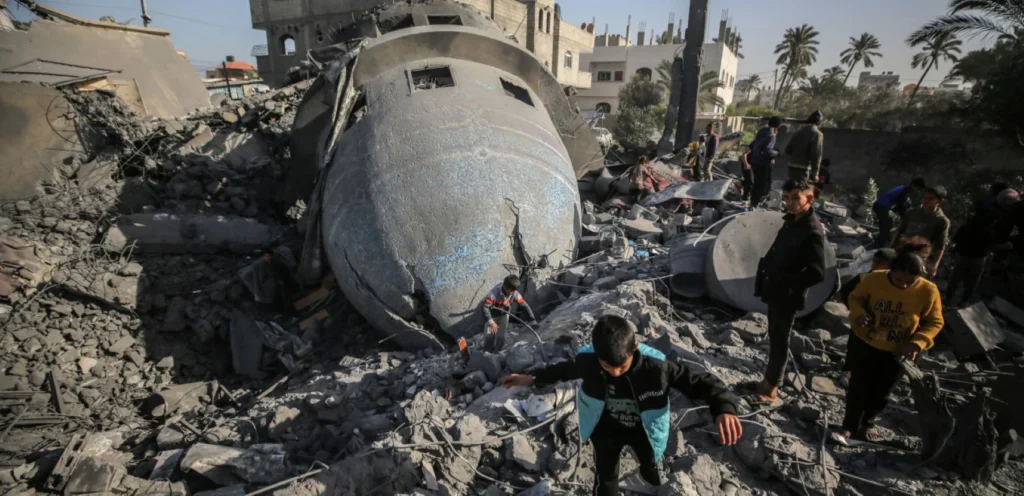The war in Gaza has become a defining humanitarian crisis of our time, testing not only the resilience of its people but also the conscience of the international community. Since October 7, 2023, the enclave has been subjected to unrelenting bombardment, mass displacement, and the collapse of essential services. What follows is not merely a chronicle of numbers and events but an attempt to understand how lives, institutions, and futures have been shattered, and why the global response must rise above rhetoric to urgent action.
The Human Cost of War
The human cost is staggering. At least 64,656 Palestinians have been killed, with thousands more still buried beneath the rubble of destroyed buildings. Among the dead are at least 404 people who died not from bombs but from starvation, including 141 children. The destruction extends far beyond immediate loss of life. Gaza’s economy has been described by the United Nations Conference on Trade and Development (UNCTAD) as in “utter ruin”, with projections that it could take centuries to recover.
Almost every sector of life has collapsed: agriculture has shrunk by 93 percent, construction by 96 percent, manufacturing by 92 percent, and services by 76 percent. More than 60 percent of housing stock has been damaged or destroyed, leaving families without shelter. Over half of health facilities are no longer operational, and hospitals that remain are overwhelmed, lacking fuel, medicine, and staff. Education has also been devastated, with nearly 88 percent of schools damaged or repurposed as shelters, denying hundreds of thousands of children their right to learn. These figures, stark as they are, only partially convey the scale of human suffering.
The Trajectory of the Conflict
The trajectory of the conflict reveals its relentlessness. In the initial phase between October 2023 and January 2025, before any pause, 46,913 Palestinians were killed as Gaza City, Khan Younis, Deir el-Balah, and Rafah were reduced to ruins. The ceasefire from January 19 to March 17, 2025, offered a fragile pause, yet even then at least 170 people were killed and about 2,200 more died from untreated injuries or were retrieved from collapsed structures. On March 18, the ceasefire collapsed, reigniting intense bombardments that claimed at least 12,059 lives up to September 2025.
United Nations agencies, from UNICEF to OCHA, issued repeated warnings of looming famine, collapsing healthcare, and the urgent need for humanitarian corridors. High Commissioner for Human Rights Volker Türk condemned attacks on hospitals and schools as flagrant violations of international humanitarian law, while the UN General Assembly passed resolutions demanding an immediate and permanent ceasefire. Yet these appeals, though morally powerful, did little to halt the devastation.
International Responses
International responses have been shaped as much by politics as by principle. The United States has remained Israel’s principal backer, providing military assistance and diplomatic cover, even as civilian casualties mounted. France and several European Union states have voiced sharp condemnation of attacks on civilians and medical facilities, calling them intolerable, yet their words have rarely been matched by decisive action. For many Palestinians, this has deepened the sense of abandonment by an international order that claims to uphold human rights.
In contrast, Pakistan has been unequivocal in its stance, describing the war as a collapse of humanity and co-sponsoring UN General Assembly resolutions that called for an unconditional ceasefire, lifting of the blockade, restoration of UNRWA’s mandate, and accountability for war crimes. Pakistan’s statements have repeatedly highlighted the deliberate targeting of hospitals, schools, and humanitarian workers, urging the global community to act rather than observe.
Journalists: Truth Under Fire
Among the most harrowing aspects of Gaza’s conflict has been the toll on journalists. At least 247 have been killed in Gaza in less than two years, making it the deadliest conflict ever recorded for media workers. These journalists were not only documenting events but providing the world with evidence of what international law defines as protected civilian spaces being systematically destroyed. Their deaths underscore how truth itself has become a casualty of this war, with deliberate attempts to silence those who bear witness.
A Humanitarian Collapse
The humanitarian crisis in Gaza is not simply a matter of politics or borders; it is a tragedy of human survival. Families are forced to choose between food and medicine, parents bury their children, and entire communities live amid rubble and loss. To watch this unfold is to confront the collapse of the very principles of protection of civilians, dignity of life, and accountability that form the bedrock of modern civilization. It is heart-wrenching not only because of the scale of destruction but because of the global inaction that allows it to continue.
The Way Forward
The role of international organizations is now more critical than ever. The United Nations, Amnesty International, Human Rights Watch, and other bodies must press beyond statements to ensure the protection of civilians, the opening of humanitarian corridors, and accountability for violations of international law. Reconstruction efforts must prioritize restoring health services, schools, housing, and water systems to offer Palestinians more than survival, to offer them a future.
The global order is being tested in Gaza, and the question remains whether it will rise to defend humanity or continue to falter in the face of political expediency. The lives lost demand more than remembrance; they demand justice, dignity, and a commitment to ensure that this cycle of devastation is not repeated.



